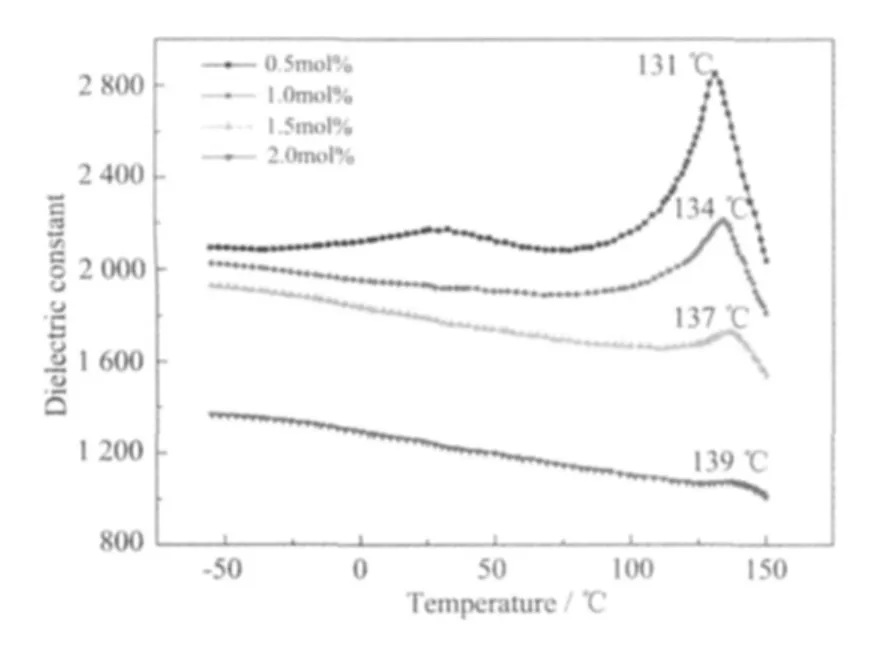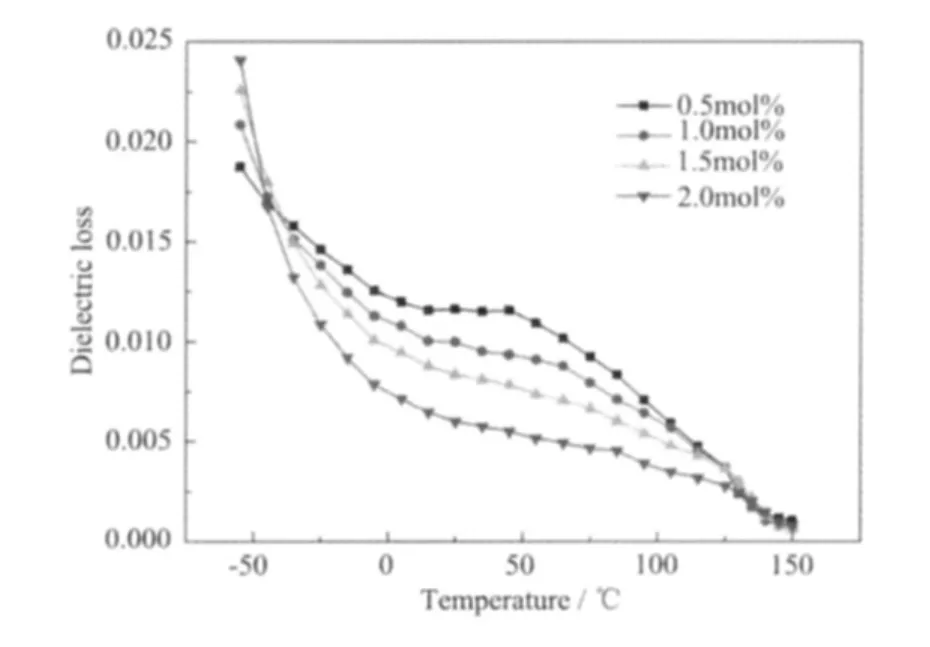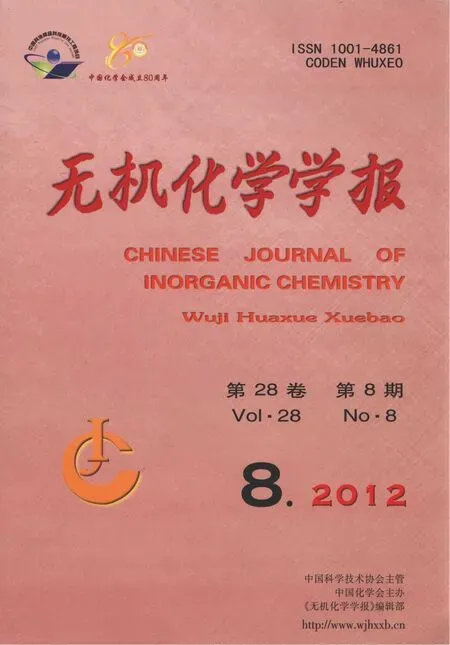Bi4(Ti1/3Sn2/3)3O12摻雜BaTiO3基X8R陶瓷微觀結構與介電性能
肖 謐 王 新 張倩倩 丁華明
(天津大學電子信息工程學院,天津 300072)
Bi4(Ti1/3Sn2/3)3O12摻雜BaTiO3基X8R陶瓷微觀結構與介電性能
肖 謐*王 新 張倩倩 丁華明
(天津大學電子信息工程學院,天津 300072)
研究了Bi4(Ti1/3Sn2/3)3O12摻雜對鈦酸鋇基陶瓷微觀結構和介電性能影響。結果表明,摻雜Bi4(Ti1/3Sn2/3)3O12后鈦酸鋇基陶瓷晶粒明顯長大,同時燒結溫度可由1 280℃降低至1 180℃。系統的介電性能和Bi4(Ti1/3Sn2/3)3O12的摻雜量有密切關系。當Bi4(Ti1/3Sn2/3)3O12的摻雜量從0.5mol%增加到2mol%,體系的居里峰被明顯壓低和展寬,當摻雜量為2mol%時居里峰變得不明顯。當Bi4(Ti1/3Sn2/3)3O12的摻雜量從0.5mol%增加到2mol%,系統的居里溫度由131℃升高至139℃。當Bi4(Ti1/3Sn2/3)3O12的摻雜量為1mol%時,鈦酸鋇基陶瓷介電常數為1 930,介電常數溫度變化率為5%(-55℃),13%(134℃),-8%(150℃),滿足X8R標準。
晶粒生長;介電性能;鈦酸鋇;X8R
0 Introduction
BaTiO3-based materials have been widely used in electronic devices such as multilayer ceramics capacitors (MLCCs)due to their excellent dielectric properties.An essential prerequisite for EIA X7Rspecification is that the relative change of capacitance(ΔC/C25℃)is within ±15%when the temperature varies from-55℃ to 125℃,where X stands for-55℃,7 stands for 125℃,and R stands for±15%.One of the primary microstructure characteristics of X7R materials is the presence of core-shell structures within individual grains[1], the core is pure ferroelectric BaTiO3and the shell around the core is modified paraelectric BaTiO3.In recent years,MLCCs have been widely used in automotive application,such as in the engine electronic control unit(ECU),antilock brake system (ABS),and programmed fuel injection (PGMFZ).The operations of these devices typically involve an engine room in which the temperature can possibly go through approximately-20℃to130℃based on different weather conditions.Furthermore the temperature is likely to rise to 150℃ifthe engine works in the extreme conditions.Therefore,MLCCswhich only satisfy the X7R specification cannot be employed and much attention hasbeen paid to MLCCssatisfying EIA X8R specification (-55 ℃ to 150 ℃,ΔC/C25℃=±15%or less,here 8 stands for 150℃)[2-4].
Currently,the development of X8R MLCCS has been focused on the BaTiO3-based ceramics.However,it is very difficult for BaTiO3to satisfy the R characteristics (ΔC/C25℃=±15%or less)when the temperature is higher than 130℃due to a sharp decrease in permittivity above the Curie temperature(about 125℃).Consequently,the modification of the composition ofBaTiO3-based ceramicshasbeen studied extensively,aiming at shiftingtheCurie temperature to a higher temperature to satisfy the X8R specification[2-12].T.A.Jain et al[2-3]demonstrated that Bi4Ti3O12could increase the Curie temperature of Mndoped BaTiO3-based ceramics and enhance the capacitance stability at high temperature due to its high Curie temperature and distorted structure,and Bi4Ti3O12can decrease the sintering temperature of BaTiO3-based ceramics due to its low melting point and liquid phase sintering at the same time.Wang Shuang[8]reported that the doping of Pb(Ti,Sn)O3can shift the Curie point of BaTiO3based ceramic from 125℃to150℃ becauseofthehighCurie temperature of Pb(Ti,Sn)O3(296℃),and acquire ceramics satisfying X8R specification.Both Bi4Ti3O12and Pb(Ti,Sn)O3are ferroelectrics,it is curious what will happen if part of Ti in Bi4Ti3O12is replaced by Sn,forming Bi4(Ti,Sn)3O12,just like the solid solution of Pb(Ti,Sn)O3,and then added into BaTiO3?So,in the presentstudy,theeffectofthe content of Bi4(Ti1/3Sn2/3)3O12on the microstructure evolution and dielectric properties of BaTiO3-based ceramics was investigated(the ratio of Ti to Sn was chosen as 1∶2).
1 Experimental
Bi4(Ti1/3Sn2/3)3O12was synthesized by solid-state reaction from Bi2O3(purity>99.9%),TiO2(purity>99.9%)and SnO2(purity>99.9%).The mixture was ball-milled by ZrO2balls in distilled water for 4 h,then dried and calcined in air at 800℃for 3 h.Commercial BaTiO3powder with a mean particle size of 0.3 micron was mixed with different amount of Bi4(Ti1/3Sn2/3)3O12(0.5,1.0,1.5 and 2.0mol%).A small amount of Nd2O3,CeO2,MnCO3,Co2O3and Nb2O5were added in all samples.The mixtures were homogenized by ball milling in distilled water for 4.5 h and dried.The mixtures were granulated using organic binders of 7wt%wax,sieved using a 80 mesh screen and pressed into pellets with a diameter of 15 mm and a height of 1mm using a pressure of 80 MPa.Sintering was conducted at 1 180℃for 2 h in air.
Crystalline phasesin sintered sampleswere identified by using an X-ray diffractometer(Model 2038X;Rigaku Co.).Cu Kα radiation (λ=0.154 18 nm)was used at 40 kV and 200 mA.The 2θ scanning range was from 20°to 80°.Microstructures on the sintered surfaceswere characterized by scanning electron microscope (SEM,Nanosem430,FEI).Dielectric measurement of the samples was performed by using a LCR meter (TH2816,Tonghui)autocontrolled by computer at 1kHz and 1.0V in the temperature range of-55℃ to 150℃.Resistivity was calculated from the insulation resistance,which was measured using a high resistance meter(Agilent Technology HP4339B)atroom temperature,the applied voltage was 100V DC and the charging time was 60s.Bulk densities of the ceramics were tested using Archimedes method.
2 Results and discussion

Fig.1 XRD patterns of the BaTiO3-based ceramics as a function of Bi4(Ti1/3Sn2/3)3O12content:(a)0.5mol%,(b)1.0mol%,(c)1.5mol%,(d)2.0mol%
Fig.1 shows the X-ray diffraction patterns of BaTiO3-based ceramics with various contents of Bi4(Ti1/3Sn2/3)3O12sintered at 1 180℃for 2 h in air.The samples show a clear single perovskite phase and no second phase is detected.The (002)and(200)diffraction peaks of the BaTiO3solid solution are attached to determine tetragonality.From the XRD analysis,the (002)and (200)diffraction peaks are separated,indicating the presence of a tetragonal phase.With the increasing of Bi4(Ti1/3Sn2/3)3O12content the (200)peak intensity decreases,which reveals the decrease of the tetragonality of BaTiO3-based ceramics.This possibly results from the diffusion of Bi4(Ti1/3Sn2/3)3O12into the core region.
The SEM micrographs of BaTiO3-based ceramics with various Bi4(Ti1/3Sn2/3)3O12contents sintered at 1 180℃are illustrated in Fig.2.It can be seen that the grain size is significantly increased when the Bi4(Ti1/3Sn2/3)3O12content is increased from 0.5mol%to 2mol%,which reveals that Bi4(Ti1/3Sn2/3)3O12doping enhances the grain growth and increases the sintering ability of BaTiO3-based ceramics.It has been stated that impurities in the shell phase exhibit a“pinning effect”on the grain structure and suppressing the grain growth[9].When the impurity content is increased,the impurity diffuses deeply into the core and reduces the suppression on the grain growth and results in the increase of grain size[10].

Fig.2 SEM micrographs of the samples surface with various Bi4(Ti1/3Sn2/3)3O12contents

Fig.3 Temperature dependence of dielectric constant of BaTiO3-based ceramics samples with various Bi4(Ti1/3Sn2/3)3O12contents
Fig.3 showsthe temperature dependence of dielectric constants of BaTiO3-based ceramics doped with various amounts of Bi4(Ti1/3Sn2/3)3O12.The dielectric constant decreases over a wide range of temperature when the Bi4(Ti1/3Sn2/3)3O12content is increased from 0.5mol% to2.0mol%.Especially,the dielectric constantpeak atCurietemperatureismarkedly depressed and broadened when the Bi4(Ti1/3Sn2/3)3O12content is increased from 0.5mol% to 2.0mol%.Moreover,when the content of Bi4(Ti1/3Sn2/3)3O12is 2mol%the Curie peak becomes inconspicuous which implies that the phase transitions from tetragonal to cubic become dispersive.It was reported[10-12]that the additive might diffuse into the grains even deeper,forming an inhomogeneous distribution of Bi3+and Ba2+in local areas, which might result in the disappearance of the core phase, and might consequently lead to the core-shell collapse when too much additives were incorporated in the BaTiO3-based ceramics.So the reduction of dielectric constant may arise from the reduction of the volume ratio of the ferroelectric core to the paraelectric shell region.
The Curie temperature shifts from 131℃to 139℃when the Bi4(Ti1/3Sn2/3)3O12content is increased from 0.5mol%to 2.0mol%.It has been stated that the Bi3+substitution at Ba-site decreases the unit cell volume,leading to a contraction at the core region and an expansion in the shell interface[2,13].The internal stress aroused by the mismatch between the core and the shell region due to the doping of Bi4(Ti1/3Sn2/3)3O12results in the Tcshift to higher temperature[2,14].
From Fig.3 we can also see that there is a dielectric constant peak at about 30℃when the doping amount of Bi4(Ti1/3Sn2/3)3O12is 0.5mol%,which is related to the phase transformation between tetragonal phase and orthorhombic phase,both of the two phases are ferroelectric.But when the doping amountis larger,the dielectric constantpeak disappears,which implies the reduction in the volume ratio of ferroelectric core in the ceramic.
The relative variation ratio of capacitance of BaTiO3-based ceramics with different Bi4(Ti1/3Sn2/3)3O12contents are illustrated in Fig.4.As is shown,the peak of the relative variation ratio of capacitance at high temperature exhibits a continuous decline,while the part at negative temperature region shows the opposite trend when the content of Bi4(Ti1/3Sn2/3)3O12increases from 0.5mol%to 2mol%.When the content of Bi4(Ti1/3Sn2/3)3O12is about 1mol%or 1.5mol%,the BaTiO3-based ceramics satisfies the EIA X8R temperature characteristic specification,which can also be attributed to the depressing and broadening of the dielectric constant peak and the shifting of Curie point to higher temperature aroused by the addition of Bi4(Ti1/3Sn2/3)3O12. The relative variation ratio of capacitance of the sample with 1mol%doping of Bi4(Ti1/3Sn2/3)3O12is about-8%at 150℃and 13%at 134 ℃.Due to the “clockwise effect”,which means the relative variation ratio of capacitance of the high temperature region will shift towards the clockwise direction when the dielectric thickness becomes thinner for MLC applications,ceramic materials can be provided as suitable candidates for EIA X8R-type multilayer ceramic capacitors.

Fig.4 Temperature coefficient of capacitance of BaTiO3-based ceramics samples with various Bi4(Ti1/3Sn2/3)3O12contents
Fig.5 demonstrates the temperature dependence ofdielectric loss ofBaTiO3-based ceramics on Bi4(Ti1/3Sn2/3)3O12content.Loss tangent data at room temperature is about 1.1%when doping amount of Bi4(Ti1/3Sn2/3)3O12is 1mol%,and decreases when the Bi4(Ti1/3Sn2/3)3O12content is increased from 0.5mol%to 2mol%,which may come from the homogeneity of the ion distribution,and the reduction of the volume ratio of the ferroelectric core to the paraelectric shell region when the doping amount is higher.Dielectric loss decreases monotonously with the increase of temperature due to the enhancement of thermo motion of the particles in BaTiO3and the shortening of relaxation time of polarization.

Fig.5 Temperature dependence of dielectric loss of BaTiO3-based ceramics samples on Bi4(Ti1/3Sn2/3)3O12content
The resistivity(ρ)and bulk density of BaTiO3-based ceramics with various Bi4(Ti1/3Sn2/3)3O12contents is shown in Fig.6.The figure shows that the BaTiO3-based ceramics sintered at 1 180℃become denser as awhole and the resistivity increaseswhen the Bi4(Ti1/3Sn2/3)3O12content is increased from 0.5mol%to 2mol%,in accordance with the grain growth shown in Fig.2,which illustrates the promotion effect of Bi4(Ti1/3Sn2/3)3O12on the sintering of BaTiO3-based ceramics.
3 Conclusions

Fig.6 Resistivity and bulk density of BaTiO3-based ceramics samples as a function of Bi4(Ti1/3Sn2/3)3O12content
1.The grain size significantly increases with the increase of Bi4(Ti1/3Sn2/3)3O12.The sintering temperature of BaTiO3-based ceramics can be lowered to 1 180℃by doping with more than 1mol%Bi4(Ti1/3Sn2/3)3O12.
2.The dielectric constantofBaTiO3-based ceramics decreases over a wide temperature range when the Bi4(Ti1/3Sn2/3)3O12content is increased from 0.5mol% to 2.0mol%,especially,the dielectric constantpeak atCurietemperatureismarkedly depressed and broadened, the Curie peak becomes inconspicuous when Bi4(Ti1/3Sn2/3)3O12is about 2.0mol%.The Curie temperature of BaTiO3-based ceramicsshiftsfrom131℃to139℃when Bi4(Ti1/3Sn2/3)3O12content is increased from 0.5mol%to 2.0mol%.
3.The high temperature peak of the relative variation ratio of capacitance exhibits a continuous decline,but the variation of capacitanceofthe negative temperature region has the opposite trend,when the Bi4(Ti1/3Sn2/3)3O12content is increased from 0.5mol%to 2mol%.
4.When the content of Bi4(Ti1/3Sn2/3)3O12is about 1mol%,the BaTiO3-based ceramics satisfy the EIA X8R temperature characteristic specification.The temperature coefficient of capacitance of the sample with 1mol%doping is 5%at-55℃,-8%at 150℃and 13%at 133℃.
[1]Lee H W,Chu Mike S H,Lu H Y.J.Am.Ceram.Soc.,2011,94(5):1556-1562
[2]Jain T A,Chen C C,Fung K Z.J.Alloys Compd.,2009,476(1/2):414-419
[3]Jain T A,Chen C C,Fung K Z.J.Eur.Ceram.Soc.,2009,29(12):2595-2601
[4]Tang B,Zhang S R,Zhou X H.J.Mater.Sci:Mater.Electron.,2007,18(5):541-545
[5]Young H S,Young H H.Jpn.J.Appl.Phys.,2005,44(8):6143-6147
[6]Nishikawa J,Hagiwara T,Kobayashi K,et al.Jpn.J.Appl.Phys.,2007,46(10B):6999-7004
[7]Yao G F,Wang X H,Yang Y,et al.J.Am.Ceram.Soc.,2010,93(6):1697-1701
[8]Wang S,Wu S H,Su H,et al.Adv.Appl.Ceram.,2010,109(6),309-312
[9]Zhang S R,Wang S,Zhou X H,et al.J.Mater.Sci.:Mater.Electron,2005,16(10):669-672
[10]Yuan Y,Zhang S R,Zhou X H,et al.J.Electron.Mater.,2009,38(5):706-710
[11]Wang S,Zhang S R,Zhou X H,et al.Mater.ett.,2005,59(19/20):2457-2460
[12]Yuan Y,Zhou X H,Zhao C J,et al.J.Electron.Mater.,2010,39(11):2471-2475
[13]Zhou L,Vilarinho P M,Baptista J L,J.Am.Ceram.Soc.,1999,82(4):1064-1066.
[14]Jung Y S,Na E S,Paik U I,et al.Mater.Res.Bull.,2002,37(9):1633-1640
Dielectric Properties and Microstructure of Bi4(Ti1/3Sn2/3)3O12Doping BaTiO3-Based X8R Ceramics
XIAO Mi*WANG Xin ZHANG Qian-Qian DING Hua-Ming
(School of Electronic and Information Engineering,Tianjin University,Tianjin 300072,China)
The effect of Bi4(Ti1/3Sn2/3)3O12addition on the microstructure and dielectric properties of BaTiO3-based ceramics was investigated.The grain size is significantly enhanced and the sintering temperature of BaTiO3-based ceramics could be lowered to 1 180℃when Bi4(Ti1/3Sn2/3)3O12is introduced.The dielectric properties are strongly correlated with the doping content of Bi4(Ti1/3Sn2/3)3O12.The dielectric constant peak and the variation rate of capacitance at Curie temperature is markedly depressed and broadened when the Bi4(Ti1/3Sn2/3)3O12content is increased from 0.5mol%to 2.0mol%.When the contentis 2mol%,the Curie peak becomes inconspicuous.The Curie temperature is shifted from 131℃to 139℃when the Bi4(Ti1/3Sn2/3)3O12content is increased from 0.5mol%to 2.0mol%.When doping 1mol%Bi4(Ti1/3Sn2/3)3O12,the BaTiO3-based ceramics exhibit a dielectric constant of 1 930,the variation of dielectric constant as compared with that at room temperature is about 5%at-55℃,13%at 134℃and-8%at 150℃,respectively.
grain growth;dielectric properties;barium titanate;X8R
TQ174.75+8.22
A
1001-4861(2012)08-1743-06
2011-11-17。收修改稿日期:2012-04-24。*
。 E-mail:xiaomi@tju.edu.cn

